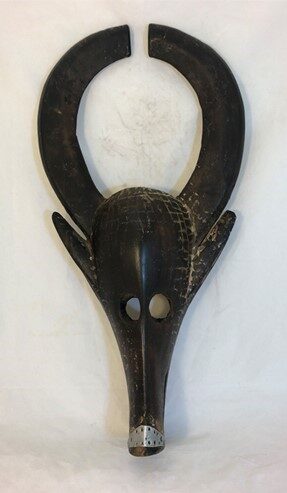
Bamana culture
Early 20th century
Wood, metal, pigment, and shoe polish,
L. 26 cm x W. 11 cm x H. 56 cm
MSU collection #2018.1.4
The Bamana culture of Western Africa is probably best-known for antelope masks, but the artists of this culture make other important masks as well. The Bamana Bush Cow Mask should not be confused with the bush cow masks of other nearby cultures; while they depict the same animal, the Bamana Bush Cow Mask is simple, organic, and curvilinear in comparison to the other bush cow masks, which have geometric decoration. Animal masks are primarily used in the Bamana Kono and Kore societies, where animal masks are physical representations of knowledge, energy, and courage.
The bush cow represents strength in the Bamana culture, and the creation of the Bush Cow Mask is based on how the people of the Bamana believe that when an animal is killed, its nyama, or “energy of action,” could be released and have revenge on its hunter. Therefore, the Bamana create this mask to serve as a vessel for the bush cow’s spirit and to give the hunter complete control of the animal’s spirit; the hunter may then acquire the bush cow’s power. Researched by Brandellia Hang
For more information, you may contact the researcher(s) noted in the title of this exhibit entry, or Dr. Billie Follensbee, the professor of the course, at BillieFollensbee@MissouriState.edu
